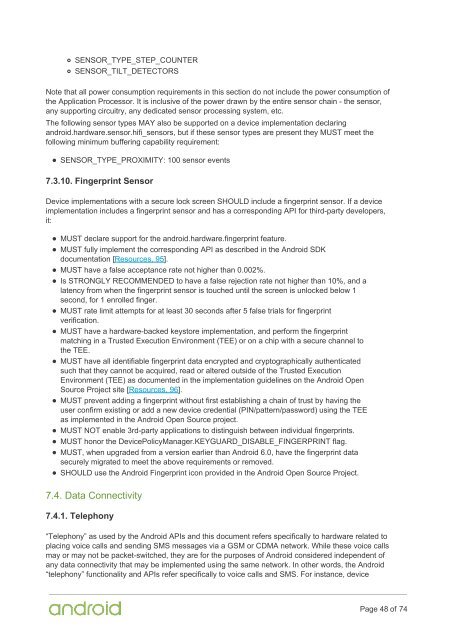Compatibility Definition
2f44OdUf0
2f44OdUf0
Create successful ePaper yourself
Turn your PDF publications into a flip-book with our unique Google optimized e-Paper software.
SENSOR_TYPE_STEP_COUNTER<br />
SENSOR_TILT_DETECTORS<br />
Note that all power consumption requirements in this section do not include the power consumption of<br />
the Application Processor. It is inclusive of the power drawn by the entire sensor chain - the sensor,<br />
any supporting circuitry, any dedicated sensor processing system, etc.<br />
The following sensor types MAY also be supported on a device implementation declaring<br />
android.hardware.sensor.hifi_sensors, but if these sensor types are present they MUST meet the<br />
following minimum buffering capability requirement:<br />
SENSOR_TYPE_PROXIMITY: 100 sensor events<br />
7.3.10. Fingerprint Sensor<br />
Device implementations with a secure lock screen SHOULD include a fingerprint sensor. If a device<br />
implementation includes a fingerprint sensor and has a corresponding API for third-party developers,<br />
it:<br />
MUST declare support for the android.hardware.fingerprint feature.<br />
MUST fully implement the corresponding API as described in the Android SDK<br />
documentation [Resources, 95].<br />
MUST have a false acceptance rate not higher than 0.002%.<br />
Is STRONGLY RECOMMENDED to have a false rejection rate not higher than 10%, and a<br />
latency from when the fingerprint sensor is touched until the screen is unlocked below 1<br />
second, for 1 enrolled finger.<br />
MUST rate limit attempts for at least 30 seconds after 5 false trials for fingerprint<br />
verification.<br />
MUST have a hardware-backed keystore implementation, and perform the fingerprint<br />
matching in a Trusted Execution Environment (TEE) or on a chip with a secure channel to<br />
the TEE.<br />
MUST have all identifiable fingerprint data encrypted and cryptographically authenticated<br />
such that they cannot be acquired, read or altered outside of the Trusted Execution<br />
Environment (TEE) as documented in the implementation guidelines on the Android Open<br />
Source Project site [Resources, 96].<br />
MUST prevent adding a fingerprint without first establishing a chain of trust by having the<br />
user confirm existing or add a new device credential (PIN/pattern/password) using the TEE<br />
as implemented in the Android Open Source project.<br />
MUST NOT enable 3rd-party applications to distinguish between individual fingerprints.<br />
MUST honor the DevicePolicyManager.KEYGUARD_DISABLE_FINGERPRINT flag.<br />
MUST, when upgraded from a version earlier than Android 6.0, have the fingerprint data<br />
securely migrated to meet the above requirements or removed.<br />
SHOULD use the Android Fingerprint icon provided in the Android Open Source Project.<br />
7.4. Data Connectivity<br />
7.4.1. Telephony<br />
“Telephony” as used by the Android APIs and this document refers specifically to hardware related to<br />
placing voice calls and sending SMS messages via a GSM or CDMA network. While these voice calls<br />
may or may not be packet-switched, they are for the purposes of Android considered independent of<br />
any data connectivity that may be implemented using the same network. In other words, the Android<br />
“telephony” functionality and APIs refer specifically to voice calls and SMS. For instance, device<br />
Page 48 of 74


